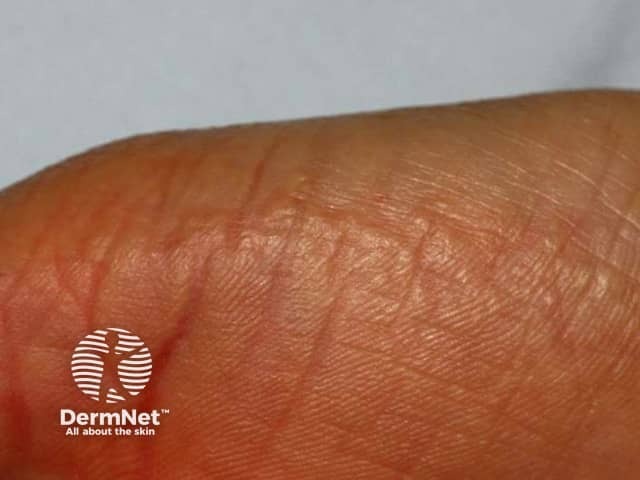Main menu
Common skin conditions

NEWS
Join DermNet PRO
Read more
Quick links
Acrokeratoelastoidosis — extra information
Acrokeratoelastoidosis
Author: Vanessa Ngan, Staff Writer, 2007. Updated by Adjunct Associate Professor Amanda Oakley, Dermatologist, Hamilton, New Zealand. July 2018.
What is acrokeratoelastoidosis?
Acrokeratoelastoidosis is an inherited form of marginal keratoderma, and is classified as a palmoplantar keratoderma. It is characterised by small firm warty or pearly papules on the sides of the hands and, in some cases, feet. It is less common than keratoelastoidosis marginalis, the inherited form of marginal keratoderma.
Acrokeratoelastoidosis was first described by Costa in 1953, hence it is sometimes called Costa acrokeratoelastoidosis. Acrokeratoelastoidosis is a form of punctate palmoplantar keratoderma type III, in which keratin and elastic tissue abnormalities are present.
Focal acral keratosis is a variant of the same disorder in which there are keratin abnormalities but elastic tissue is normal on histopathological examination.

Probable acrokeratoelastoidosis
Who gets acrokeratoelastoidosis and why?
Acrokeratoelastoidosis is a rare genetic skin disorder with autosomal dominant inheritance patterns (if one parent is affected there is a 50% chance that each child will be affected). Sporadic cases have also occurred.
Acrokeratoelastoidosis usually starts in childhood, adolescence or early 20s, and appears to affect females more frequently than males. It can occur in skin of colour, with most reports of focal acral keratosis occurring in dark skin.
The precise cause of acrokeratoelastoidosishas not yet been determined. A possible linkage to chromosome 2 has been proposed.
What are the signs and symptoms of acrokeratoelastoidosis?
Signs and symptoms of acrokeratoelastoidosis start to arise at around puberty or sometimes later. Small clusters of skin-coloured or yellowish papules slowly develop over the sides of the hands and feet. The papules are about 2–5 mm in diameter, roundish, discrete, and firm on palpation.
How is the diagnosis of acrokeratoelastoidosis made?
In most cases, acrokeratoelastoidosis is a clinical diagnosis determined by age of onset, family history, absence of other signs of sun damage, and findings on skin biopsy.
- Histopathological examination reveals focal hyperkeratosis, acanthosis, hypergranulosis and elastorrhexis.
- Elastorrhexis is absent in focal acral keratosis.
What is the treatment for acrokeratoelastoidosis?
Because acrokeratoelastoidosis is a genetic disorder, no cure is available. Treatment is also not indicated as in most patients, once developed, the eruption is stable and causes no problems. Mild keratolytics such as urea cream have been used to relieve any dryness.
References
- Zanini Maurício. Focal acral hyperkeratosis: case report and discussion on marginal keratodermas. An Bras Dermatol. [Internet]. 2006 Oct [cited 2018 July 14]; 81(Suppl 3): S293–6. Journal.
- OMIM – Online Mendelian Inheritance in Man (search term Acrokeratoelastoidosis)
On DermNet
- Marginal keratoderma
- Keratoelastoidosis marginalis (acquired marginal keratoderma)
- Collagenous and elastotic marginal plaques of the hands pathology
- Palmoplantar keratoderma
- Punctate palmoplantar keratoderma
- Foot skin problems
- Hand skin problems
Other websites
- Acrokeratoelastoidosis – Medscape Reference
- Palmoplantar keratoderma, punctate III; PPKP3. Omim.
